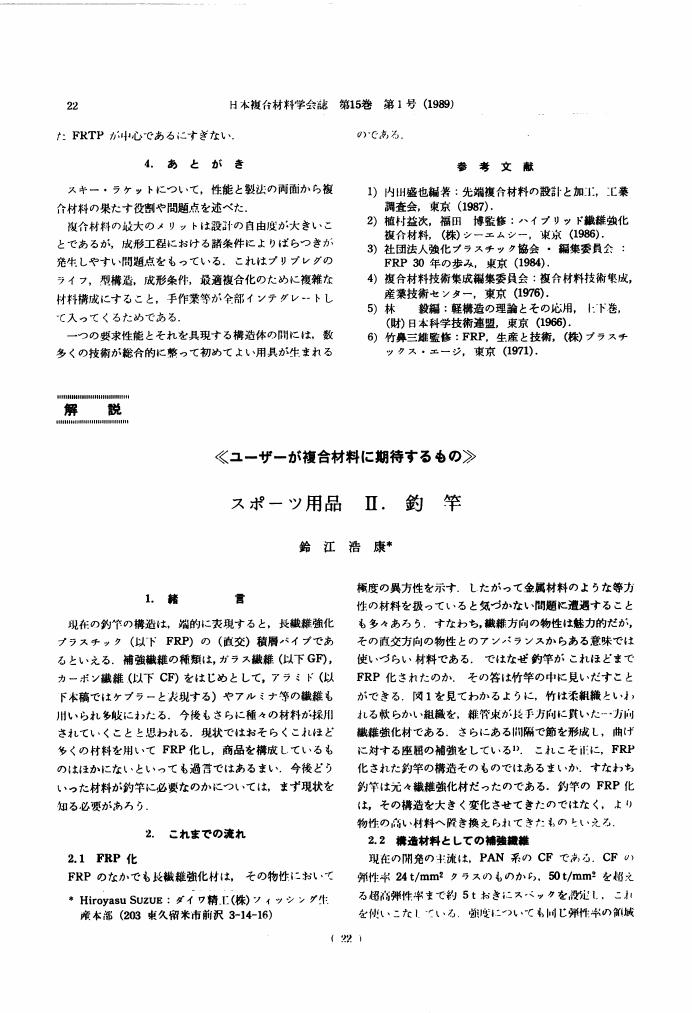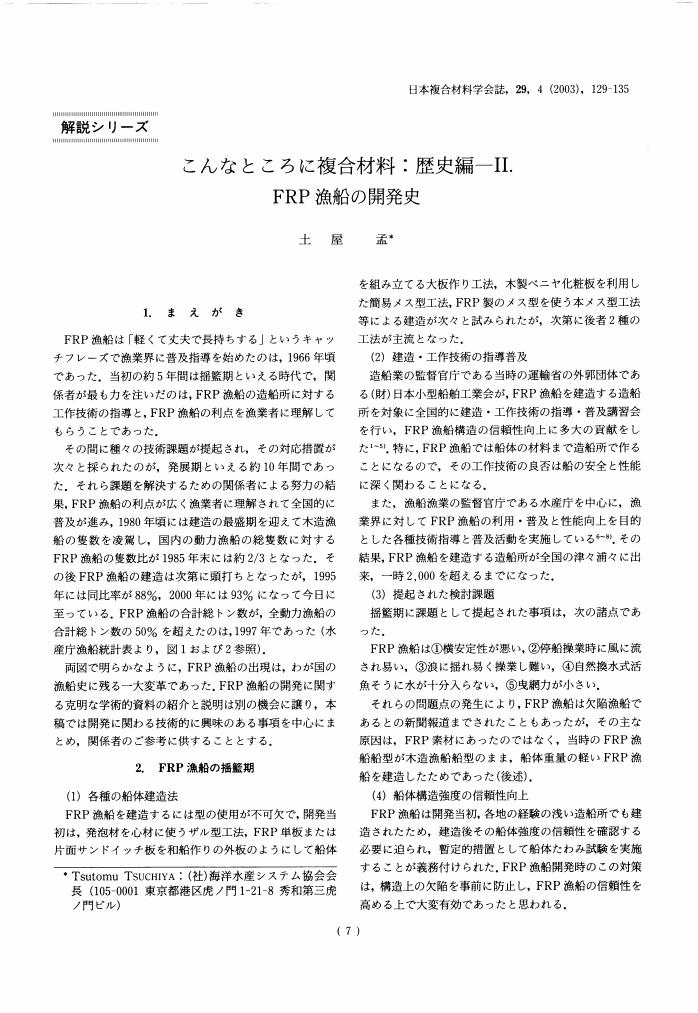7 0 0 0 OA 複合材料力学入門 第3章 積層板の理論と最適設計の基礎
- 著者
- 福永 久雄
- 出版者
- 一般社団法人 日本複合材料学会
- 雑誌
- 日本複合材料学会誌 (ISSN:03852563)
- 巻号頁・発行日
- vol.22, no.3, pp.114-119, 1996-03-15 (Released:2009-08-11)
- 参考文献数
- 7
- 被引用文献数
- 3 2
7 0 0 0 OA 複合材料力学入門 第2章 複合材料の弾性・非弾性挙動
- 著者
- 石川 隆司
- 出版者
- 一般社団法人 日本複合材料学会
- 雑誌
- 日本複合材料学会誌 (ISSN:03852563)
- 巻号頁・発行日
- vol.22, no.2, pp.76-81, 1996-03-15 (Released:2009-08-11)
- 参考文献数
- 11
- 被引用文献数
- 1 1
5 0 0 0 OA XF-2の一体成形複合材主翼構造の開発
3 0 0 0 OA 複合材料力学入門 第10章 複合材料の強度則
- 著者
- 座古 勝 倉敷 哲生
- 出版者
- 一般社団法人 日本複合材料学会
- 雑誌
- 日本複合材料学会誌 (ISSN:03852563)
- 巻号頁・発行日
- vol.23, no.4, pp.144-150, 1997-07-15 (Released:2009-08-11)
- 参考文献数
- 16
3 0 0 0 OA 複合材料力学入門
- 著者
- 福田 博
- 出版者
- 一般社団法人 日本複合材料学会
- 雑誌
- 日本複合材料学会誌 (ISSN:03852563)
- 巻号頁・発行日
- vol.22, no.1, pp.19-25, 1996-01-15 (Released:2009-08-11)
- 参考文献数
- 4
- 被引用文献数
- 6
2 0 0 0 OA こんなところに複合材料:歴史編ーIV.FRP浴槽開発史
- 著者
- 小柳 卓治
- 出版者
- 一般社団法人 日本複合材料学会
- 雑誌
- 日本複合材料学会誌 (ISSN:03852563)
- 巻号頁・発行日
- vol.29, no.6, pp.205-209, 2003-11-15 (Released:2009-08-11)
2 0 0 0 OA 複合材料力学入門 第7章 航空機構造の設計の実例とその成形方法の特徴
- 著者
- 戸井 康弘 中村 裕之
- 出版者
- 一般社団法人 日本複合材料学会
- 雑誌
- 日本複合材料学会誌 (ISSN:03852563)
- 巻号頁・発行日
- vol.23, no.1, pp.31-38, 1997-01-15 (Released:2009-08-11)
- 参考文献数
- 8
2 0 0 0 OA 航空機の複合材部品の修理法
- 著者
- 田草川 照彦
- 出版者
- 一般社団法人 日本複合材料学会
- 雑誌
- 日本複合材料学会誌 (ISSN:03852563)
- 巻号頁・発行日
- vol.25, no.6, pp.211-218, 1999-11-15 (Released:2009-08-11)
- 被引用文献数
- 1 1
1 0 0 0 OA 3D造形した連続繊維熱可塑性CFRPの圧縮特性に関する実験的評価
- 著者
- 干川 大和 白須 圭一 岡部 朋永
- 出版者
- 一般社団法人 日本複合材料学会
- 雑誌
- 日本複合材料学会誌 (ISSN:03852563)
- 巻号頁・発行日
- vol.48, no.4, pp.142-148, 2022-07-15 (Released:2023-07-29)
- 参考文献数
- 20
- 被引用文献数
- 1
Recent years have witnessed the development of 3D printing systems of continuous carbon fiber reinforced thermoplastics (CFRTP) for use in various applications. In terms of convenience, 3D printing of CFRTP has attracted considerable attention in various fields and industries. In this study, non- and open-hole compressive (NHC and OHC) properties of 3D-printed CFRTP were evaluated. In an NHC test, the compressive elastic modulus and strength in the fiber alignment (0º) direction were obtained with values of 58.1±4.0 GPa and 368.0±33.3 MPa, respectively. A theoretical study of the relationship between compressive strength and the initial fiber misalignment angle showed that the latter was greater than that of conventional hot-pressed CFRTPs, suggesting that the fiber waviness of 3D printing has a negative effect on the longitudinal compressive strength. In an OHC test, cross-ply laminates with center holes were prepared, where the OHC strength was 165.6±1.2 MPa. Both fracture surface and X-ray CT observations showed that kink bands occurred in the 0º layer at the edge of the center hole and that extensive delamination was observed at the 0º/90º interface around the hole. These observations suggest that the voids attributed to 3D printing merged with the delamination derived from fiber buckling near the center hole, leading to rapid expansion of the delamination.
1 0 0 0 OA シアネート硬化エポキシ樹脂の熱機械特性に関する実験的評価と分子動力学シミュレーション
- 著者
- 川越 吉晃 小森 翔平 菊川 豪太 白須 圭一 岡部 朋永
- 出版者
- 一般社団法人 日本複合材料学会
- 雑誌
- 日本複合材料学会誌 (ISSN:03852563)
- 巻号頁・発行日
- vol.48, no.4, pp.134-141, 2022-07-15 (Released:2023-07-29)
- 参考文献数
- 26
Recently, carbon-fiber-reinforced plastic (CFRP) has been increasingly used in the aerospace industry. To apply CFRP as an aircraft-grade structural material, thermosetting resin is used as a matrix to achieve high mechanical properties and environmental resistance. Additionally, the development of multifunctional CFRPs using matrix resins with functional properties, such as flame retardance, heat resistance, and vibration damping, is ongoing. In this study, molecular dynamics (MD) simulations and experiments were performed to analyze the thermomechanical properties of epoxy/cyanate resins compared with those of conventional epoxy/amine resins, to evaluate the application of this heat resistant resin as an aircraft-grade structural material. This study clarified the properties of epoxy/cyanate resins, which had no cure shrinkage, high glass transition temperature, and low thermal conductivity. These properties are attributed to the characteristic cross-linked structure of epoxy/cyanate resins, which demonstrates their potential as a structural material for next-generation aircrafts.
1 0 0 0 OA 《ユーザーが複合材料に期待するもの》スポーツ用品 II. 釣竿
- 著者
- 鈴江 浩康
- 出版者
- 一般社団法人 日本複合材料学会
- 雑誌
- 日本複合材料学会誌 (ISSN:03852563)
- 巻号頁・発行日
- vol.15, no.1, pp.22-25, 1989-01-15 (Released:2009-08-11)
- 参考文献数
- 3
1 0 0 0 OA 数値材料試験とニューラルネットワークを用いた一方向CFRPの界面接着強度の予測
- 著者
- 鷹見 凌 染宮 聖人 平山 紀夫 山本 晃司 松原 成志朗 石橋 慶輝 寺田 賢二郎
- 出版者
- 一般社団法人 日本複合材料学会
- 雑誌
- 日本複合材料学会誌 (ISSN:03852563)
- 巻号頁・発行日
- vol.48, no.1, pp.32-39, 2022-01-15 (Released:2023-02-10)
- 参考文献数
- 26
When analyzing the fracture behavior of unidirectional carbon fiber-reinforced polymer (CFRP), it is important to consider the interfacial strength between the reinforcing fiber and the base resin, and the strength of the base resin. Therefore, the adhesiveness of the base material and the compatibility with the sizing material and fibers are important design parameters in the development of CFRPs. However, a quantitative method for estimating the interfacial strength and the strength of the base resin has not been established. In this study, we propose a method to evaluate the interface strength of unidirectional CFRPs by creating learning data through a series of numerical material tests and by constructing a neural network that outputs the interface strength based on a homogenization method from the results of off-axis tensile tests. We adopt a general feed forward neural network whereby parameters are learned by employing a backpropagation method. The interfacial strength and the matrix resin strength is predicted and evaluated from the results of the off-axis tensile test to demonstrate the effectiveness of this system.
1 0 0 0 OA こんなところに複合材料:歴史編―I. 大阪万博におけるFRP
- 著者
- 高橋 儀徳
- 出版者
- 一般社団法人 日本複合材料学会
- 雑誌
- 日本複合材料学会誌 (ISSN:03852563)
- 巻号頁・発行日
- vol.29, no.3, pp.90-97, 2003-05-15 (Released:2009-08-11)
- 参考文献数
- 1
1 0 0 0 OA こんなところに複合材料 釣竿における複合材料
- 著者
- 黒川 智弘
- 出版者
- 一般社団法人 日本複合材料学会
- 雑誌
- 日本複合材料学会誌 (ISSN:03852563)
- 巻号頁・発行日
- vol.25, no.3, pp.122-126, 1999-05-15 (Released:2009-08-11)
- 参考文献数
- 8
1 0 0 0 OA ≪複合材料の挑戦―I≫ 異方性の積極利用(I)
- 著者
- 福田 博
- 出版者
- 一般社団法人 日本複合材料学会
- 雑誌
- 日本複合材料学会誌 (ISSN:03852563)
- 巻号頁・発行日
- vol.14, no.1, pp.20-25, 1988-01-15 (Released:2009-08-11)
- 参考文献数
- 6
- 被引用文献数
- 1
1 0 0 0 OA 3Dプリント連続炭素繊維強化熱可塑複合材料の引張試験特性
- 著者
- 轟 章 大浅田 樹 水谷 義弘 鈴木 良郎 上田 政人 松崎 亮介 平野 義鎭
- 出版者
- 一般社団法人 日本複合材料学会
- 雑誌
- 日本複合材料学会誌 (ISSN:03852563)
- 巻号頁・発行日
- vol.45, no.4, pp.141-148, 2019-07-15 (Released:2020-07-29)
- 参考文献数
- 11
- 被引用文献数
- 1
Continuous carbon fiber composites can be printed with 3D printers. Many studies detailing elucidations of the mechanical properties of such 3D printed composites have been published, all of which employed a conventional tensile specimen configuration with surface resin layers. In the present study, 0º, 90º, ±45º, and lay-up direction type specimens were newly designed for 3D printed composites without surface layers. Using the 3D printer, both conventional and newly designed specimens with serpentine folded fiber bundles were fabricated and investigated experimentally. The lay-up direction specimen was fabricated using 800 layers. The specimens without the serpentine folded fiber bundles were experimentally shown to be adequate for tensile tests. The lay-up direction specimen had the lowest strength and stiffness, which seems to be related to its surface roughness.
1 0 0 0 OA ロケットターボポンプ用軸受の保持器複合材の潤滑特性
- 著者
- 野坂 正隆
- 出版者
- 一般社団法人 日本複合材料学会
- 雑誌
- 日本複合材料学会誌 (ISSN:03852563)
- 巻号頁・発行日
- vol.20, no.6, pp.215-223, 1994-11-15 (Released:2009-08-11)
- 参考文献数
- 12
1 0 0 0 OA 三次元織物技術の動向
- 著者
- 安居 義治
- 出版者
- 一般社団法人 日本複合材料学会
- 雑誌
- 日本複合材料学会誌 (ISSN:03852563)
- 巻号頁・発行日
- vol.26, no.5, pp.163-170, 2000-09-15 (Released:2009-08-11)
- 参考文献数
- 25
1 0 0 0 OA こんなところに複合材料 航空・宇宙での複合材料の適用拡大
- 著者
- 小笠原 和夫
- 出版者
- 一般社団法人 日本複合材料学会
- 雑誌
- 日本複合材料学会誌 (ISSN:03852563)
- 巻号頁・発行日
- vol.27, no.6, pp.292-294, 2001-11-15 (Released:2009-08-11)
- 参考文献数
- 3
1 0 0 0 OA こんなところに複合材料:歴史編―II.FRP漁船の開発史
- 著者
- 土屋 孟
- 出版者
- 一般社団法人 日本複合材料学会
- 雑誌
- 日本複合材料学会誌 (ISSN:03852563)
- 巻号頁・発行日
- vol.29, no.4, pp.129-135, 2003-07-15 (Released:2009-08-11)
- 参考文献数
- 16















